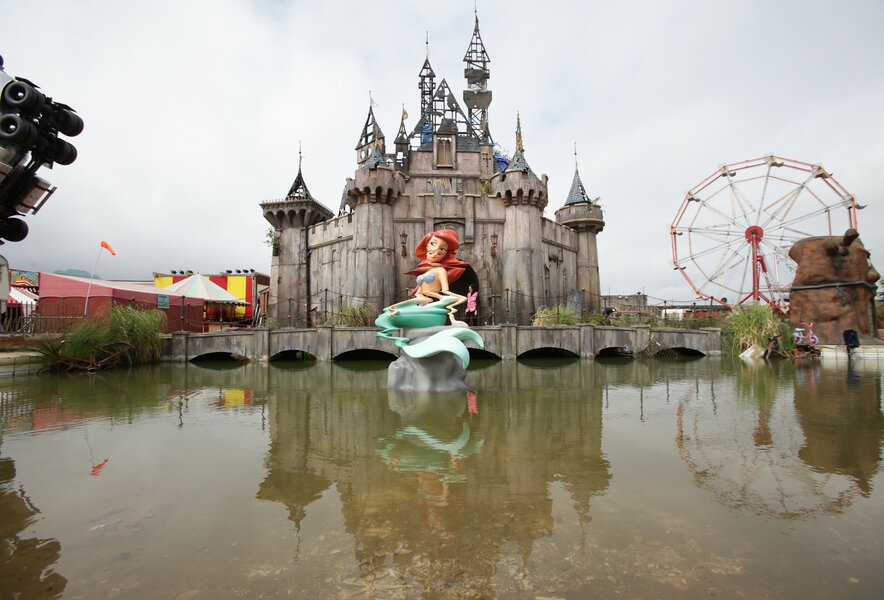Banksy’s scowling 'Dismaland' closes after five weeks of politics and profit
Loading...
Impossibly bored, sulking employees; stagnant “fairy-tale” moats; and throngs of hipsters carting “I am an imbecile” balloons: the fun will all come to an end at Dismaland Sunday night, when street-art phenomenon Banksy’s satirical theme park shuts up shop for good after performances by Pussy Riot, De La Soul, and even – just possibly – a rumored appearance by Eminem.
Likely to cause even more of a stir, however, is the appearance of Banksy himself, the broadly anti-establishment graffiti artist whose politically-loaded designs have taken the art world by storm, even as critics grumble that he’s not anti-establishment enough. He’s “The $20 Million Graffiti Artist Who Doesn’t Want His Art To Be Worth Anything,” as Forbes’ Danielle Rahm put it, still unidentified after years of fame, and he will attend the grand finale of his five-week installation, his biggest yet, only on the condition that all party-goers don masks.
Before Banksy, “Dismaland” was an abandoned public swimming pool in the faded UK beachside town of Weston-super-Mare. An invited team of 50 artists transformed the boardwalk into a temporary “bemusement” park that left some of its 150,000 visitors feeling caught in a bind, unsure if their love of all things Banksy implicated them in the same capitalist consumer mindset that the installation set out to critique.
Dismay-seekers entered the park through a mock airport security scanner, then chose from a smorgasbord of equally sinister, or just cynical, entertainment options: taking selfies in front of Cinderella’s lifeless body amid fake car-crash wreckage, for instance, or driving remote-controlled migrant rafts around a tiny pool as they’re chased by European powerboats. (There was also the option for visitors to take the helm of the coast guard boat themselves.)
In an interview offered on his, or her, website, Banksy comments that Dismaland’s
been labelled as ‘twisted’ but I’ve never called it that. We just built a family attraction that acknowledges inequality and impending catastrophe. I would argue it’s theme parks which ignore these things that are the twisted ones.
Elsewhere, he’s opined that “theme parks should have bigger themes.”
It would appear that legions of fans agree. Hours-long queues of visitors from around the world buoyed Weston-super-Mare’s economy by £20 million pounds, or about $30 million dollars, since Dismaland’s gates opened on August 21. “It will be a shame to see it go,” local hotel manager Wayne Entwhistle told the Guardian.
Although the bedraggled, predominantly grey-and-brown visuals of Britain’s self-declared “most disappointing new visitor attraction” first caught tourists’ eyes, Dismaland’s uniquely uncharming charm stemmed just as much from its human side.
In a video posted to Mashable.com, the cheerful park-goer asks an employee, “Are you having a good time here?”
“What do you think?” she deadpans, looking pained by his questions in her bright-pink security vest and Mickey Mouse ears.
“You’re having a terrible time, aren’t you?”
“Yeah, it’s rubbish.”
“It is controversial, it is in bad taste and it makes people think – that’s what art should do,” Pussy Riot member Nadezhda Tolokonnikova told the Guardian. The Russian activist band’s performance at Dismaland this weekend, their first-ever live set, criticized European nations’ response to the migrant crisis with a song written especially for the occasion.
Not all critics are sold on Banksy’s approach to provocative art. Although art producer Kath Cockshaw calls him “the street art king of meaning," it’s a title that makes other critics, and political artists, squirm.
New York Magazine critic Jerry Saltz has attributed Banksy’s mass appeal to the “frisson” people feel around something “slightly bad-boy,” “anarchy-lite.” The Guardian’s art critic Jonathan Jones blasted Dismaland as “a charade where everyone has to pretend this is a better joke than it really is,” art that “claims to be making you think” while, in reality, providing little more than photo ops.
Is "thinking" enough for Banksy? It’s unclear. “Why should children be immune from the idea that to maintain our standard of living other children have to die trapped in the hulls of boats in the bottom of the Mediterranean?” he asks, calling out adults who “have convinced themselves small incremental change and buying organic tomatoes is enough.”
How about buying a theme park ticket? Would Dismaland have been most successful if no one had shown up?
There’s no way to tell, for now. Dismaland’s homepage announces the next stop is “Dismaland Calais,” noting, “No online tickets will be available.”








